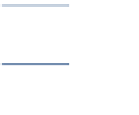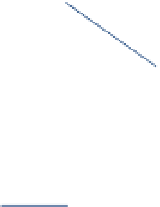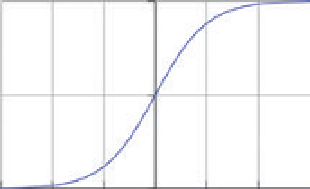Information Technology Reference
In-Depth Information
Fig. 13.16. Representation of an artificial
neuron with inputs, connection weights,
and the output subject to a threshold
function.
Inputs
Weights
W
1
I
1
W
2
I
2
Output
Sum
W
3
∑
I
3
Threshold
W
4
I
N
of McCulloch and Pitts, the input could only be either 0 or 1. In addition,
each input “dendrite” had an associated “weight” that was either +1 or -1 to
represent inputs that tended either to excite the neuron to fire or to inhibit
the neuron from firing, respectively. The model calculated the weighted
sum of the inputs - the sum of each input multiplied by its weight - and
checked whether this sum was greater or smaller than the threshold value.
If the weighted sum was greater than the threshold, the model neuron fired
and emitted a 1 on its axon. Otherwise, the output remained 0. Rosenblatt's
perceptron model allowed both the inputs to the neurons and the weights to
take on any value. In addition, the simple activation threshold was replaced
by a smoother
activation function
, a mathematical function used to transform
the activation level of the neuron into an output signal, such as the function
shown in
Figure 13.17
. ANNs are just interconnected layers of perceptrons as
shown in
Figure 13.18
.
For numerical calculations, computers are very much faster than
humans at performing arithmetic. For tasks involving
pattern recognition -
the automatic identification of figures, shapes, forms, or patterns to recog-
nize faces, speech, handwriting, objects, and so on - even young children
are still very much better than the most powerful computers. The hope for
ANN research is that by mimicking how our brains learn, these artificial
networks can be trained to recognize patterns. The study of ANNs is some-
times called
connectionism
.
The publication of a famous topic
Perceptrons
in 1969 by Marvin Minsky
and Seymour Papert from MIT dashed early hopes for progress with neural net-
works. Minsky and Papert showed that a simple two-layer perceptron network
was incapable of learning some very simple patterns. While they did not rule
out the usefulness of multilayer perceptron networks with what they called
“hidden” layers, they pointed out “the lack of effective learning algorithms”
22
for such networks. This situation changed in the 1980s with the discovery of
just such an effective learning algorithm. A very influential paper in the jour-
nal
Nature
gave the algorithm its name: “Learning Representations by Back-
Propagating Errors” by David Rumelhart, Geoffrey Hinton (
B.13.9
), and Ronald
Williams. Let us see how this
back-propagation
algorithm enables neural net-
works to learn.
1
0.5
0
-6 -4 -2
Fig. 13.17. A simple threshold function
for an artificial neuron. The strength of
the output signal depends on the magni-
tude of the sum of the input signals.
0
2
4
6















Search WWH ::

Custom Search